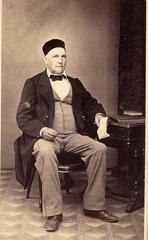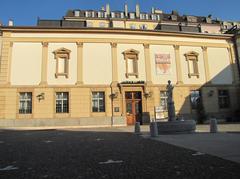
Neuchâtel Castle: Visiting Hours, Tickets, and Historical Sites Guide
Date: 04/07/2025
Introduction
Neuchâtel Castle, perched majestically above the city and shimmering Lake Neuchâtel, is a symbol of Swiss heritage and architectural splendor. Tracing its origins to the late 10th century, this iconic fortress has been a seat of power, a princely residence, and now serves as the heart of cantonal administration. With its striking white facades, elegant turrets, and commanding sentry walk, Neuchâtel Castle offers visitors a compelling journey through Swiss history, culture, and panoramic beauty. This comprehensive guide details everything you need to know for a memorable visit: from opening hours and tickets to accessibility, guided tours, and nearby attractions. For further details, consult resources such as Jura & Three Lakes and Switzerland Tour.
Historical Overview
Origins and Evolution
Neuchâtel Castle’s history begins around 1011 CE, when it was first referenced as a fortified residence for local nobility. Its strategic location on a rocky spur allowed control over vital trade routes and the surrounding fertile lands. Over the centuries, the structure expanded into a formidable medieval stronghold, acquiring defensive walls, towers, and residential quarters. The adjacent Collegiate Church, constructed in the 12th century, further elevated its significance as both a religious and administrative hub (Jura & Three Lakes; Switzerland Tour).
Political and Strategic Importance
Throughout the Middle Ages, Neuchâtel Castle was the residence of the Counts of Neuchâtel and played a central role in regional politics and conflicts. Its fortifications were reinforced during the 15th and 16th centuries, reflecting its enduring military and administrative value (Switzerland Tour).
Transition and Modern Use
In 1707, Neuchâtel came under Prussian rule, and the castle transformed into a princely residence with modernized interiors and ceremonial halls. Following its peaceful integration into the Swiss Confederation in 1848, the castle became the seat of the cantonal government, a role it maintains today (Thrillophilia).
Visiting Neuchâtel Castle
Opening Hours
- April to October: Tuesday to Sunday, 10:00–17:00.
- November to March: Tuesday to Sunday, 10:00–12:00 and 13:30–16:00.
- Closed: Mondays, December 25, and January 1.
Always check the official website for the latest updates before your visit.
Ticket Information
- Adults: CHF 8
- Students/Seniors: CHF 6
- Children (under 16): Free
- Groups (10+): CHF 6 per person
Guided tours require an additional fee (CHF 10–15 per person) and grant access to exclusive areas like the ceremonial halls and towers (Neuchâtel Tourism).
Guided Tours & Special Events
- Guided Tours: Available April to September in French, German, and English (advance booking recommended for English tours). Tours last about 60–75 minutes and provide in-depth historical and architectural context.
- Events: The castle hosts annual medieval festivals, temporary exhibitions, and cultural events. Check the local events calendar for upcoming activities.
Accessibility
- Mobility: Some areas are accessible to wheelchairs (main courtyard and select exhibition rooms), but medieval architecture limits full access. Strollers are allowed in the courtyard.
- Facilities: Modern restrooms, a seasonal café, and a gift shop are available on-site.
- Assistance: Contact the visitor center for detailed accessibility information (official accessibility guide).
Getting There
- By Train: Neuchâtel railway station is a 15-minute walk or a short bus ride (bus 101, “Château” stop) from the castle (Swiss Sage; Real Journey Travels).
- By Bus: Lines 101 and 107 stop at “Place Pury,” followed by a scenic 10-minute uphill walk (TransN network).
- By Car: Paid parking is available at Parking du Seyon and Parking Place Pury; old town streets are mostly pedestrian.
- On Foot/Bike: Enjoy charming old town streets or use Neuchâtel’s bike-sharing system for a moderately challenging climb.
- By Boat: Lake cruises offer unique views of the castle’s silhouette.
Highlights of Neuchâtel Castle
- Sentry Walk & Ramparts: Panoramic views of Lake Neuchâtel, the Alps, and the old town—ideal for photographers (Jura & Three Lakes).
- Medieval Kitchens & Chapel: Preserved interiors offer a glimpse into daily life and religious practices (Thrillophilia).
- Grand Ceremonial Hall: Hosts historic events and modern receptions.
- Collegiate Church: The adjacent 12th-century Romanesque-Gothic church features remarkable vaulted ceilings and chapels, including a statue of Reformation leader Guillaume Farel (Swiss Sage).
Practical Tips for Visitors
- Best Time to Visit: May–September for pleasant weather and extended hours; off-peak winter months are quieter.
- Dress Code: Comfortable shoes for cobblestone streets and steep paths; dress in layers and bring rain protection.
- Photography: Permitted for personal use; flash and tripods not allowed indoors. Drones prohibited.
- Children: Supervise near high walls and towers.
- Amenities: Free public Wi-Fi, restrooms, seasonal café, and gift shop.
- Tourist Card: Overnight visitors receive the Neuchâtel Tourist Card for free public transport and museum access, including the castle (Swiss Sage; Jura & Three Lakes).
Nearby Attractions
- Old Town: Winding alleys, artisan boutiques, and vibrant market squares.
- Lake Promenade: Ideal for strolls and boat tours.
- Laténium Archaeology Museum: Switzerland’s largest archaeological museum (Adventure Backpack).
- Restaurants: Traditional Swiss cuisine at Le Jura and contemporary options at Brasserie Le Cardinal.
Frequently Asked Questions (FAQ)
Q: What are Neuchâtel Castle’s opening hours?
A: Tuesday to Sunday; see above for seasonal details.
Q: How much do tickets cost?
A: Adults CHF 8; discounts for students/seniors; children under 16 free. Guided tours extra.
Q: Are guided tours available?
A: Yes, in multiple languages. Advance booking is recommended, especially for English tours.
Q: Is the castle wheelchair accessible?
A: Partial accessibility; some historic areas remain challenging.
Q: Can I take photos inside the castle?
A: Yes, but flash and tripods are not allowed indoors.
Q: How do I get there?
A: Train, bus, car, bike, or boat; see “Getting There” above for details.
Essential Contacts
- Tourist Information: Neuchâtel Tourism Office, Place du Port 2, 2000 Neuchâtel, +41 32 889 68 90.
- Emergency Numbers: Police 117, Fire 118, Ambulance 144.
- Lost Property: Lost & Found Neuchâtel.
Sustainability & Visitor Conduct
- Use recycling bins and respect signage.
- Do not touch artifacts or disturb quiet spaces.
- Only service animals are allowed inside.
Conclusion
Neuchâtel Castle is a must-see for anyone interested in Swiss history, architecture, and culture. With its layered past, panoramic vistas, and central location in a vibrant old town, the castle provides a rewarding experience for every visitor. Check official resources for up-to-date information on tickets, hours, and special events, and consider downloading the Audiala app for audio guides and insider tips. Make your journey to Neuchâtel Castle an unforgettable part of your Swiss adventure!
Sources
- Jura & Three Lakes
- Switzerland Tour
- Real Journey Travels
- Neuchâtel Tourism
- Swiss Sage
- Thrillophilia
- Adventure Backpack
- TransN network
- Neuchâtel railway station
- Le Jura
- Brasserie Le Cardinal
- Auberge de Jeunesse Neuchâtel
- Hôtel Alpes & Lac
- Collegiate Church
- Official accessibility guide
- Official Neuchâtel Castle website
- Lost & Found Neuchâtel













